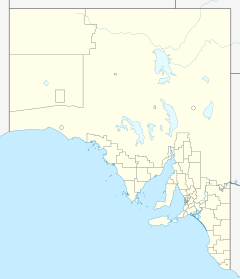Kirkala facts for kids
Kirkala Station is a large piece of land in South Australia used for farming. It's known as a pastoral lease, which means someone rents the land from the government to raise animals. Kirkala Station is mainly a sheep station, where thousands of sheep are raised.
You can find Kirkala Station about 12 kilometres (7 mi) east of Streaky Bay. It's also about 112 kilometres (70 mi) north west of Wudinna. Both of these towns are on the Eyre Peninsula in South Australia.
What's in a Name?
The name "Kirkala" is quite special. It comes from the language of the Aboriginal people who have lived on this land for thousands of years. "Kirkala" is the word for a plant called "pig face" (scientific name: Carpobrotus rossii). This plant grows naturally in the area around the station.
A Look Back in Time
Early Days
Kirkala Station was first set up before 1858. A man named Hugh Archibald Crawford, who used to run a grocery store, decided to start a new life in farming. He took over Kirkala with his brother-in-law, James Munro Linklater. Crawford later became a Justice of the Peace for the Streaky Bay area. This meant he helped keep law and order in the community.
Changing Hands
In 1868, Kirkala Station was put up for sale. It was sold along with a nearby property called Hope Downs Station. Together, these two stations covered a huge area of 270 square miles (699 km2). They had about 11,100 sheep! The properties were well-equipped for their time. They had:
- An eight-bedroom stone house (the homestead)
- A smaller cottage
- A store
- Huts for workers
- A stable for horses
- 12 wells to provide water for the animals
Later in 1868, the Linklater family became the only owners of Kirkala. Then, in 1892, a person named Spottiswood Montgomery bought the station.
Protecting History
Today, some important parts of Kirkala Station are protected. They are listed on the South Australian Heritage Register. This means they are considered historically important and efforts are made to preserve them. The protected areas include:
- The main station area, with the original homestead
- A building that served as both a school and a dining room for shearers (people who shear sheep)
- The stables
- The blacksmith's shop
- A cottage
- An outstation, which is a smaller, separate part of the property. This outstation has a two-room cottage, an outdoor bakehouse, and an underground water tank.


